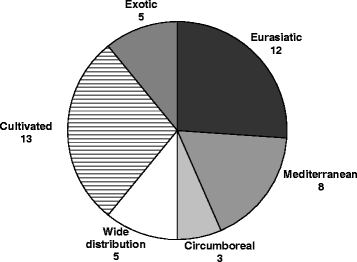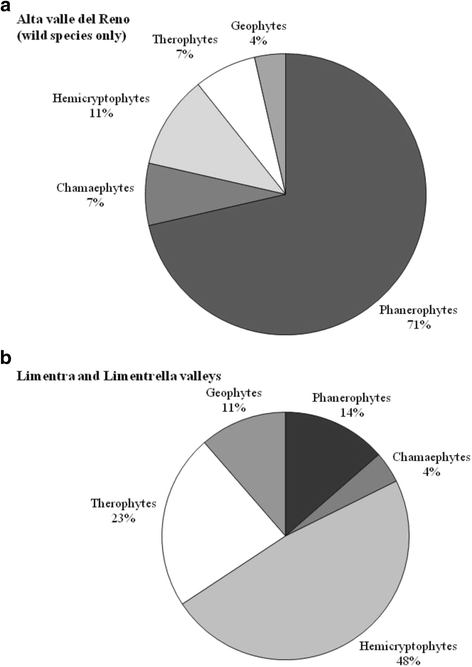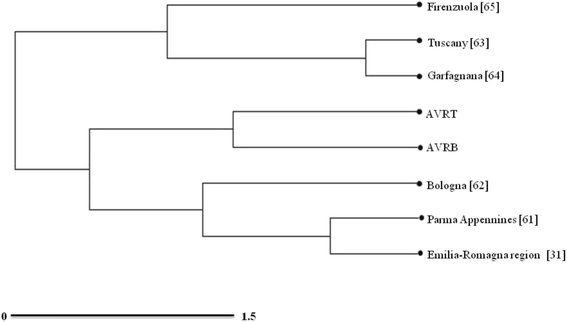Traditional alcoholic beverages and their value in the local culture of the Alta Valle del Reno, a mountain borderland between Tuscany and Emilia-Romagna (Italy)
- PMID: 27333772
- PMCID: PMC4917955
- DOI: 10.1186/s13002-016-0099-6
Traditional alcoholic beverages and their value in the local culture of the Alta Valle del Reno, a mountain borderland between Tuscany and Emilia-Romagna (Italy)
Abstract
Background: Traditional alcoholic beverages (TABs) have only received marginal attention from researchers and ethnobotanists so far, especially in Italy. This work is focused on plant-based TABs in the Alta Valle del Reno, a mountainous area on the border between Tuscany and Emilia-Romagna regions. The aims of our study were to document local knowledge about TABs and to analyze and discuss the distribution of related knowledge within the investigated communities.
Methods: Field data were collected through semi-structured interviews. The relative importance of each plant species used to prepare TABs was assessed by calculating a general Use Value Index (UV general), a current UV (UV current) and a past UV (UV past). We also assessed personal experience of use by calculating effective and potential UV (UV effective, UV potential). A multivariate analysis was performed to compare ingredients in recipes recorded in the Alta Valle del Reno with those reported for neighboring areas.
Results: Forty-six plant species, belonging to 20 families, were recorded. Rosaceae was the most significant family (98 citations, 19 species), followed by Rutaceae (15, 3) and Lamiaceae (12, 4). The most important species was Prunus cerasus L. (UV general = 0.44), followed by Juglans regia L. (0.38), Rubus idaeus L. (0.27) and Prunus spinosa L. (0.22). Species with the highest UV current were Juglans regia (0.254), Prunus cerasus (0.238) and Citrus limon L. (0.159). The highest UV effective values were obtained by Prunus cerasus (0.413), Juglans regia (0.254), Rubus idaeus (0.222) and Citrus limon (0.206). We also discuss the results of the multivariate analysis.
Conclusions: TABs proved to occupy an important place in the traditional culture and social life of the studied communities. Moreover, data highlight the local specificity and richness of this kind of tradition in the Alta Valle del Reno, compared to other Italian areas. Some plant ingredients used for TABs have potential nutraceutical and even therapeutic properties that are well known by local people. These properties could constitute an additional economic value for TABs' commercialization, which in turn could promote the local rural economy.
Keywords: Aromatized wines; Distillates; Ethnobotany; Fermented beverages; Liquors.
Figures






References
-
- McGovern P. Uncorking the past: The quest for wine, beer, and other alcoholic beverages. Berkley: University of California Press; 2009.
-
- Rivera D, Matilla G, Obón C, Alcaraz F. Plants and Humans in the Near East and the Caucasus. The Landscapes. The Plants: Ferns and Gymnosperms, Vol. 1. Murcia: Editum & Plants and Humans; 2012.
-
- Rivera D, Matilla G, Obón C, Alcaraz F. Plants and Humans in the Near East and the Caucasus. The Landscapes. The Plants: Angiosperms, Vol. 2. Murcia: Editum & Plants and Humans; 2012.
MeSH terms
LinkOut - more resources
Full Text Sources
Other Literature Sources
Miscellaneous

